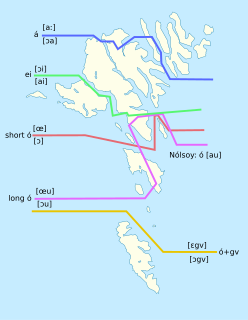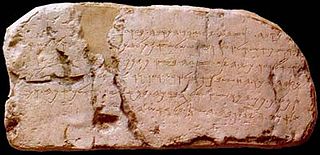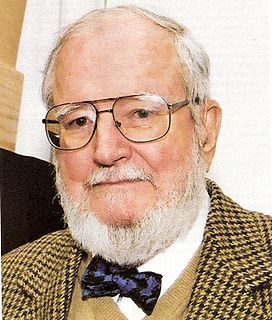Related Research Articles

The Semitic languages are a branch of the Afroasiatic language family. They are spoken by more than 330 million people across much of West Asia, the Horn of Africa, and latterly also North Africa, Malta and in small pockets in the Caucasus as well as in often large immigrant and expatriate communities in North America, Europe, and Australasia. The terminology was first used in the 1780s by members of the Göttingen School of History, who derived the name from Shem, one of the three sons of Noah in the Book of Genesis.

Geʽez is an ancient Ethiopian Semitic language. The language originates from what is now Eritrea and northern Ethiopia.
Ugaritic is an extinct Northwest Semitic language, classified by some as a dialect of the Amorite language and so the only known Amorite dialect preserved in writing. It is known through the Ugaritic texts discovered by French archaeologists in 1929 at Ugarit, including several major literary texts, notably the Baal cycle. It has been used by scholars of the Hebrew Bible to clarify Biblical Hebrew texts and has revealed ways in which the cultures of ancient Israel and Judah found parallels in the neighboring cultures.

An isogloss, also called a heterogloss, is the geographic boundary of a certain linguistic feature, such as the pronunciation of a vowel, the meaning of a word, or the use of some morphological or syntactic feature. Major dialects are typically demarcated by bundles of isoglosses, such as the Benrath line that distinguishes High German from the other West Germanic languages and the La Spezia–Rimini Line that divides the Northern Italian languages from Central Italian dialects. However, an individual isogloss may or may not have any coterminus with a language border. For example, the front-rounding of /y/ cuts across France and Germany, while the /y/ is absent from Italian and Spanish words that are cognates with the /y/-containing French words.
The Canaanite languages, or Canaanite dialects, are one of the three subgroups of the Northwest Semitic languages, the others being Aramaic and Ugaritic, all originating in the Levant and Mesopotamia. They are attested in Canaanite inscriptions throughout the Levant, Mesopotamia, Anatolia and the East Mediterranean region. Dialects have been labelled primarily with reference to Biblical geography: Hebrew, Phoenician/Carthaginian, Amorite, Ammonite, Ekronite, Moabite and Edomite; the dialects were all mutually intelligible, being no more differentiated than geographical varieties of Modern English. This family of languages has the distinction of being the first historically attested group of languages to use an alphabet, derived from the Proto-Canaanite alphabet, to record their writings, as opposed to the far earlier Cuneiform logographic/syllabic writing of the region.

Biblical Hebrew, also called Classical Hebrew, is an archaic form of the Hebrew language, a language in the Canaanite branch of Semitic languages spoken by the Israelites in the area known as the Land of Israel, roughly west of the Jordan River and east of the Mediterranean Sea. The term "Hebrew" (ibrit) was not used for the language in the Bible, which was referred to as שפת כנען or יהודית, but the name was used in Ancient Greek and Mishnaic Hebrew texts.
Proto-Semitic is the hypothetical reconstructed proto-language ancestral to the Semitic languages. There is no consensus regarding the location of the Proto-Semitic Urheimat; scholars hypothesize that it may have originated in the Levant, the Sahara, or the Horn of Africa, and the view that it arose in the Arabian Peninsula has also been common historically.
Aleph is the first letter of the Semitic abjads, including Phoenician ʾālep 𐤀, Hebrew ʾālef א, Aramaic ʾālap 𐡀, Syriac ʾālap̄ ܐ, and Arabic alif ا. It also appears as South Arabian 𐩱, and Ge'ez ʾälef አ.
Northwest Semitic is a division of the Semitic languages comprising the indigenous languages of the Levant. It emerged from Proto-Semitic in the Early Bronze Age. It is first attested in proper names identified as Amorite in the Middle Bronze Age. The oldest coherent texts are in Ugaritic, dating to the Late Bronze Age, which by the time of the Bronze Age collapse are joined by Old Aramaic, and by the Iron Age by the Canaanite languages.
Jimmy Jack McBee Roberts, known as J. J. M. Roberts, is William Henry Green Professor of Old Testament Literature (Emeritus) at Princeton Theological Seminary in Princeton, New Jersey. A member of the Churches of Christ, Roberts attended Abilene Christian University before pursuing doctoral work at Harvard University.

Frank Moore Cross Jr. (1921–2012) was the Hancock Professor of Hebrew and Other Oriental Languages Emeritus at Harvard University, notable for his work in the interpretation of the Dead Sea Scrolls, his 1973 magnum opusCanaanite Myth and Hebrew Epic, and his work in Northwest Semitic epigraphy. Many of his essays on the latter topic have since been collected in Leaves from an Epigrapher's Notebook.
Gerald "Gary" Neil Knoppers was a professor in the Department of Theology at University of Notre Dame. He wrote books and articles regarding a range of Old Testament and ancient Near Eastern topics. He is particularly renowned for his work on 1 Chronicles, writing I Chronicles 1 - 9 and I Chronicles 10 - 29, which together comprise a very significant treatment of the work of the Chronicler. In May 2005 the Canadian Society of Biblical Studies/Societe canadienne des Etudes bibliques granted the R. B. Y. Scott Award to Knoppers for his two-volume Anchor Bible commentary on I Chronicles
Thomas Oden Lambdin was a leading scholar of the Semitic and Egyptian languages. He received his Ph.D. in 1952 from the Johns Hopkins University Department of Near Eastern Studies, where his advisor was William Foxwell Albright; his dissertation was on "Egyptian Loanwords and Transcriptions in the Ancient Semitic Languages." He was appointed as an associate professor of Semitic Languages at Harvard University in 1964. He retired from Harvard in 1983 and served as Professor Emeritus until his death. He was admired not only for his research and his "tireless teaching", but for the quality of his introductory textbooks on Biblical Hebrew, Coptic, Ge'ez and Gothic language. His Festschrift, Working with No Data: Semitic and Egyptian Studies Presented to Thomas O. Lambdin includes a full bibliography of his publications, as well as chapters by John Huehnergard and Richard J. Clifford about their experiences as his students
Francis Ian Andersen was an Australian scholar in the fields of biblical studies and Hebrew. Together with A. Dean Forbes, he pioneered the use of computers for the analysis of biblical Hebrew syntax. He taught Old Testament, History, and Religious Studies at various institutions in Australia and the United States, including Macquarie University, the University of Queensland, and Fuller Theological Seminary. His published works include the Tyndale commentary on Job, and Anchor Bible commentaries on Hosea, Amos, Habakkuk and Micah, and over 90 papers.

Richard C. Steiner is a Semitist and a scholar of Northwest Semitic languages, Jewish Studies, and Near Eastern texts. His work has focused on texts from as early as the Egyptian Pyramid texts to as late as medieval biblical interpretation. He is now retired from his position as professor of Semitics at the Bernard Revel Graduate School of Yeshiva University in New York City.

Israelian Hebrew is a northern dialect of biblical Hebrew (BH) proposed as an explanation for various irregular linguistic features of the Masoretic Text (MT) of the Hebrew Bible. It competes with the alternative explanation that such features are Aramaisms, indicative either of late dates of composition, or of editorial emendations. Although IH is not a new proposal, it only started gaining ground as a challenge to older arguments to late dates for some biblical texts since about a decade before the turn of the 21st century: linguistic variation in the Hebrew Bible might be better explained by synchronic rather than diachronic linguistics, meaning various biblical texts could be significantly older than many 20th century scholars supposed.
The earliest known precursor to Hebrew, an inscription in the Paleo-Hebrew alphabet, is the Khirbet Qeiyafa Inscription, if it can be considered Hebrew at that early a stage.
Michael Patrick O'Connor was an American scholar of the Ancient Near East and a poet. With the field of ANE studies he was a linguist of Semitic languages, with a focus on biblical Hebrew and biblical poetry.
Jo Ann Hackett is an American scholar of the Hebrew Bible and of Biblical Hebrew and other ancient Northwest Semitic languages such as Phoenician, Punic, and Aramaic.
John Huehnergard is a Canadian-American specialist in Semitic languages, notable for his work on categorization, etymology, and historical linguistics.
References
- ↑ Philippi, F. W. M. (1878). "Das Zahlwort Zwei im Semitischen". Zeitschrift der Deutschen Morgenländischen Gesellschaft. 32: 21–98.
- ↑ Morschauser, Scott; Thomas O. Lambdin (1985). "Philippi's Law Reconsidered". In Ann Kort (ed.). Biblical and Related Studies Presented to Samuel Iwry. Winona Lake, Indiana: Eisenbrauns. pp. 135–145. ISBN 9780931464232.
- ↑ Blake, Frank R. (1950). "The Apparent Interchange between a and i in Hebrew". Journal of Near Eastern Studies. 9 (2): 76–83. doi:10.1086/370960. JSTOR 542721. S2CID 161219913.
- ↑ Morschauser, Scott; Thomas O. Lambdin (1985). "Philippi's Law Reconsidered". In Ann Kort (ed.). Biblical and Related Studies Presented to Samuel Iwry. Winona Lake, Indiana: Eisenbrauns. p. 136. ISBN 9780931464232.
- ↑ Huernergard, John (1992). Walter Ray Bodine (ed.). Linguistics and Biblical Hebrew. Eisenbrauns. pp. 212–216. ISBN 9780931464553. (citing several sources in footnotes 19-27).
- ↑ Huehnergard, John. "Philippi’s Law." Encyclopedia of Hebrew Language and Linguistics. Edited by: Geoffrey Khan. Brill Online, 2013. Reference. URL. Retrieved 10 December 2013.
- ↑ Paul Joüon (Translated by T. Muraoka). A Grammar of Biblical Hebrew: Subsidia Biblica. Gregorian Biblical BookShop, 2006. ISBN 9788876536298. Pages 88, 90, 117, 138, 147, 223, 279, 293 (n. 1).